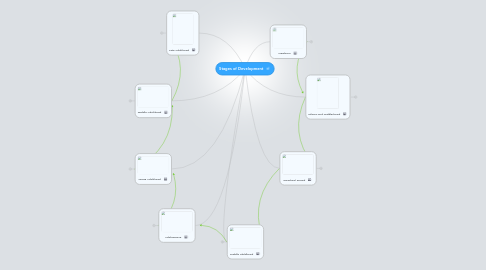Stages of Development
by Cael Wear


1. Middle Childhood
1.1. Physical Development: Growth becomes slow and steady. Gross motor skills and fine motor skills continue to improve.
1.2. Cognitive Development: Ability to apply logical operations to problems. Understanding of conservation and transformation. Can take multiple perspectives into account. Memory encoding, storage, and retrieval improve. Language pragmatics and meta-linguistic awareness improve.
1.3. Social/Personality: Refer to psychological traits to define themselves. Social comparison is used to understand ones standing and identity. Self-esteem grows differentiated. Appraoch moral problems intent on maintaining social respect. Friendship patters differ, boys mostly interact with boys.
2. Adolescence
2.1. Physical Development: Boys growth spurt around age 12. Boys puberty starts around age 13-14. Primary sexual characteristics develop, as well as secondary sexual characteristics.
2.2. Cognitive Development: Abstract thought prevails. Relative, not absolute thinking is typical. Verbal and mathematical skills improve. Ability to think hypothetically. Ego-centrism develops. A sense of invulnerability can lead adolescents to ignore danger.
2.3. Social/Personality: Self-concept becomes organized and accurate. Defining identity is a key task. Quest for autonomy can bring conflict with parents as family roles are renegotiated. Sexuality assumes importance in identity formation. Dating begins.
3. Young Adulthood
3.1. Physical Development: Physical capabilites peak in the 20's including strength, senses, coordination, and reaction time. Growth is mostly complete, except for brain and other organs. Obesity becomes a threat for the first time. Disease replaces accidents for leading cause of death for the first time.
3.2. Cognitive Development: Thought becomes more flexible and subjective, geared to adept problem solving. Intelligence is applied to long-term goals. Significant life events of young adulthood may shape cognitive development.
3.3. Social/Personality: Forming intimate relationships becomes highly important. Marriage and children bring developmental changes. Identity is largely defined in terms of work.
4. Middle Adulthood
4.1. Physical Development: Changes become evident, vision declines and hearing. Height reaches a peak and declines slowly. Reaction time slows. Women experience menopause
4.2. Cognitive Development: Some loss of cognitive functioning may begin in middle adulthood, but overall cognitive competence holds steady because adults use life experience and effective strategies to compensate. Slight declines occur in the efficiency of retrieval from long term memory.
4.3. Social/Personality: Take stock, appraising accompishments against a "social clock" and develop consciousness of mortality. Midlife Crisis occurs. The view of ones career shifts from outward ambition to inner satisfaction, or dissatisfaction.
5. Late Adulthood
5.1. Physical Development: Wrinkles and gray or thinning hair are marks of late adulthood. Height declines, brain shrinks, heart pumps less blood, and senses become less acute. Chronic diseases may occur.
5.2. Cognitive Development: Declines are minimal until the 80's. But can be maintained with training and practice. Short term memory and memory of specific life episodes may decline, other types of memory are largely unaffected.
5.3. Social/Personality: Basic peronality traits remain stable, but changes are possible. Life review can bring either fulfillment or dissatisfaction. Retirement causes adjustment to self-concept and self-esteem.
6. Newborn
6.1. Physical Development: Growth of about 1-1.5 inches in the first month. Gain weight at about 4-8 oz. A week.
6.2. Cognitive Development: Brain developing rapidly, improved by positive interaction with parents.
6.3. Social/Emotional: Newborn learns how to communicate quickly, by seeking interaction, and making facial expressions. Other things like crying when uncomfortable are included.
7. Infancy and Toddlerhood
7.1. Physical Development: Rapid height and weight gains. Improved vision. Improved hearing. Reach, grasp, and pick up small items. Movement increases.
7.2. Cognitive Development: Understanding of object permanence. Use of representations and symbols. Information-processing improves. Rapid language development.
7.3. Social/Personality: Different temperaments and activity levels. Facial expressions reflect emotions, and understanding of others facial expressions. Feeling of empathy, an attachment style immerges
7.3.1. Online Help
7.3.2. Use Cases & Templates
7.3.2.1. Personal Todo List
7.3.2.2. Vacation Planning
7.3.2.3. Meeting Minutes
7.3.2.4. Project Plan
7.3.2.5. more...
7.3.3. Tools and Gadgets
7.3.3.1. Offline Mode
7.3.3.2. Geistesblitz Tools
7.3.3.3. Email & SMS Gateways
7.3.3.4. Offline Mode
